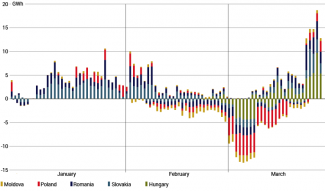Ukraine: a major blow to the energy sector
22 March saw the biggest attack on the Ukrainian electricity infrastructure since the beginning of the war, during which Russia launched 151 rockets and UAVs. Just like the shelling carried out during the previous heating season, the main targets included electricity generation facilities (both heating and hydroelectric power plants) and distribution stations. As a result of the attack, Ukraine’s biggest hydroelectric power station, the Dnipro Hydroelectric Power Plant (DHPP) in Zaporizhzhia, was destroyed, although the dam itself suffered no damage. The DTEK company, which accounts for around 70% of the electricity generated in heating & power plants, announced that it had lost almost 50% of its generation capacity in this segment. In Kharkiv, the biggest heat and power plant (TEC-5) and all the transformer stations were destroyed. In order to keep the electricity grid stable, Ukrenergo (the national power operator) announced emergency shutdowns in seven oblasts and applied for emergency assistance from Poland, Slovakia and Romania.
The shelling continued on a smaller scale in the following days, attacking the Kryvyi Rih, Odesa and Mykolaiv oblasts. As of 27 March, not all customers had had their electricity supplies restored. The situation is particularly difficult in Kharkiv, where work to restore electricity supplies to all residents will take up to two weeks, provided no new shelling occurs. Moreover, an underground gas storage facility was targeted for the first time since the launch of the Russian invasion. However, according to a press release published by Naftogaz, this has not disrupted the operation of the gas transmission system.
Commentary
- The loss of a significant portion of the balancing capacity, which enables the operators to regulate the amount of electricity fed to the grid to keep the daily supply and demand in balance, poses the biggest problem to Ukraine. The nuclear power plants, which form the basis for Ukraine’s electricity generation (being responsible for over 50% of electricity production in the country), have very limited capability in this respect. The task of system balancing is carried out by thermal power plants (the majority of which are owned by DTEK) and by hydroelectric power stations. In this situation, the loss of the DHPP (1.5 GW of installed capacity) and of almost half of DTEK’s electricity generation potential poses a serious challenge to the grid operator. To some degree, electricity imports from neighbouring countries can serve to stabilise the situation (following the latest Russian attack, these imports reached levels unprecedented since the beginning of 2024; see Chart 1). However, if electricity consumption increases in summer it is likely that the government will decide to return to scheduled power shutdowns for individual customers similar to those applied last winter.
- Although the attack has not resulted in problems for the electricity grid as serious as those which occurred in October and November 2022 (see ‘Russia is destabilising the energy system in Ukraine’), the damage should be viewed as very severe. This is because the DHPP and TEC-5 will be restored to operation no sooner than a year from now, even in the most optimistic scenario. As regards the TEC-5, the magnitude of its damage will pose a problem ahead of the next winter because this plant is the main source of heat for a significant part of Kharkiv city. Alongside this, it should be noted that Ukraine’s initiatives to protect its infrastructure against shelling (see ‘Ukraine: the electricity system is readying itself for Russian attacks’) have proved insufficient in mass-scale attacks. However, had these initiatives not been carried out, the scale of the damage would have been significantly bigger.
- Contrary to what the Ukrainian authorities and military intelligence had expected, prior to 22 March the Russians did not carry out massive shelling of energy infrastructure during the 2023/4 heating season. Although there had been individual instances of the infrastructure being struck, the main targets included military and industrial facilities. The timing of the recent attack came as a surprise because, due to the rising daily temperature, at the end of March the electricity grid’s load is smaller than during frosty winter months, reducing the risk of a blackout. It cannot be ruled out that this attack was launched as a form of revenge for the attacks on Russian oil refineries which Ukraine has carried out in recent weeks.
Chart. Ukraine’s daily electricity exports (-) and imports (+) since the beginning of 2024

Source: ENTSO-E.




